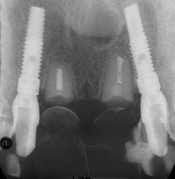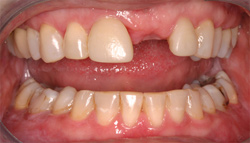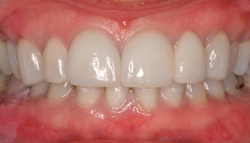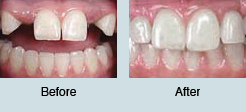



Periodontal Disease
Dental Implants
Gum Tissue Grafting
Cosmetic Periodontal Surgery
Crown Lengthening
Osseous Surgery
Guided Tissue Regeneration
Bone Grafting
Orthodontic Surgery
Dental Implants

Dental implants are designed to provide a foundation for replacement teeth that look, feel, and function like natural teeth. The person who has lost teeth regains the ability to eat without worry and smile with confidence, knowing that teeth appear natural and that facial contours will be preserved.
The implants themselves are tiny titanium posts that are placed into the jawbone where teeth are missing, acting as tooth root substitutes. The bone bonds with the titanium, creating a strong foundation for artificial teeth. Small posts are then attached to the implant which protrude through the gums. These posts provide stable anchors for artificial replacement teeth (crowns). Implants help prevent the bone deterioration which occurs when teeth are missing.
For some patients, the placement of dental implants may first require a bone grafting procedure called ridge preservation. Ridge preservation is necessary to build up the boney ridge of your jaw before an implant can be placed.
In some cases, sinus augmentation may be necessary. Sinus augmentation is a procedure to correct insufficient bone quantity and close proximity to your sinuses. Dr Huber will raise the sinus floor above your upper back jaw and use bone grafting techniques to improve the quantity and quality of the bone tissue for later placement of implants.
In a second surgery, the implants will be placed. For the first three to six months following surgery, the implants are beneath the surface of the gums, gradually bonding with the jawbone. You should be able to wear temporary dentures made by your general dentist during this time. Your restorative dentist will design the final bridgework, crown or denture, which will ultimately improve both function and aesthetics.
Finally, after the implant has integrated with the jawbone, the next phase begins. Dr Huber will uncover the implants and attach a small healing abutment. After about four to six weeks, your general dentist will be able to start making your new teeth. An impression must be taken. Then posts or attachments can be connected to the implants which hold the new teeth. The entire procedure usually takes four to six months. Most patients do not experience any disruption in their daily life.
Home - Initial Exam - Financial Info - Insurance - Scheduling - Dr. Huber - Procedures - Info - Map - Forms